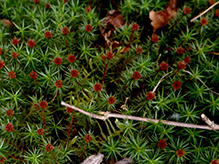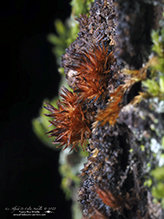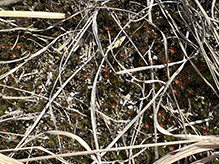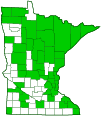juniper haircap moss
(Polytrichum juniperinum)
Conservation • Description • Habitat • Ecology • Use • Distribution • Taxonomy
Conservation Status |
|
|||||||
| IUCN Red List | not listed |
|||||||
| NatureServe | NNR - Unranked SNR - Unranked |
|||||||
| Minnesota | not listed |
|||||||
Description |
||
Juniper haircap moss is a very common and very widespread moss with a worldwide distribution, occurring on every continent including Antarctica. In North America it has been recorded in every Canadian province and in every U.S. state except Texas, Louisiana, and Florida. It is common in Minnesota. It is found in a wide variety of habitats, including upland open woodlands, savannas, sand prairies, roadsides, trail sides, rocky ledges, and creek banks. It sometimes colonizes forest openings following a fire or a blowdown. It grows under full sun to light shade, in dry conditions, on acidic, gravelly or sandy soil, or on thin soil over rock. Juniper haircap moss is a fairly robust, perennial, evergreen, moss. It grows in tufts and has an upright growth habit (acrocarp). It rises on multiple aerial stems from a horizontal underground stem (rhizome). It is highly variable in size but usually 1 9⁄16″ to 2″ (4 to 5 cm) tall. In a rock crevice it may be just ⅜″ (1 cm) tall. In areas where it competes with common haircap moss it may reach 4″ (10 cm). It usually forms loose to moderately dense colonies, and often forms extensive patches. The aerial stems are erect or ascending, unbranched, and densely leafy. They are round and yellowish-brown or reddish-brown, The leaves are narrow, linear to linear lance-shaped, stiff, and ⅛″ to ¼″ (3 to 6 mm) long. They resemble juniper leaves. This is the feature that gives the species its common name. When moist, they are flat, not wavy, and they spread straight out in all directions from the stem. When dry, they are straight, not twisted, and they fold upward against the stem. The base of the leaf forms a sheath that wraps around the stem. The sheath is oblong-rectangular, glossy, and yellowish with transparent margins. The leaf blade consists of a very wide midrib (costa) with a flat portion (lamina) on each side. The costa is prominently arced in cross section. The lamina is dark green or bluish-green. The margins are thin and translucent (membranous). They are mostly toothless but there are sometimes a few teeth near the tip. The lamina folds sharply over the costa, protecting it from drying out, and giving the leaf a glossy appearance. The leaf tip is narrowly pointed and reddish-brown. It is extended but there is no true awn. The stem, leaves, and root-like structures (rhizoids), together are the gametophyte phase of the moss life cycle. Male reproductive structures (antheridia) and female reproductive structures (archegonia) are borne on separate plants at the tip of the stem. Each is subtended by a rosette of modified leaves. On male plants the flower-like rosettes are yellowish to reddish-green and ⅛″ to 3 ⁄16″ (4 to 5 mm) in diameter. Sperm is accumulated in the “splash cup” and is dispersed by water droplets. When a sperm lands on the tip of a female plant, it swims down the archegonia to the egg. The fertilized egg produces a spore-producing structure (sporophyte). The sporophyte consists of a foot, which attaches the sporophyte to the gametophyte, a long stalk (seta), and a capsule. At maturity, the seta is stout, yellowish to reddish-brown, and 1 3⁄16″ to 2″ (3 to 5 cm) long. When immature, the capsule is round and green. At the end of the capsule there is an opening that is covered with a membranous hood (operculum). The operculum is cone-shaped with a short beak-like projection. The entire capsule is covered with a hood (calyptra). The calyptra is membranous, whitish to light brown, and covered with a felt of densely interwoven, matted hairs. This is the feature that gives the genus its common name. As it matures, the capsule develops a ring around the opening (annulus). At maturity the calyptra falls off revealing a sharply rectangular, reddish-brown to dark brown, ⅛″ to 3⁄16″ (2.5 to 5.0 mm) long capsule. The annulus forces the operculum to drop off exposing the capsule opening with a ring of 64 teeth. The spores are dispersed by wind. |
||
Growth Form |
||
Acrocarp |
||
Height |
||
⅜″ to 4″ (1 to 10 cm) |
||
Similar Species |
||
Habitat |
||
Dry. A wide variety of habitats, including open woodlands, forests openings, savannas, sand prairies, roadsides, trail sides, rocky ledges, and creek banks. Acidic, gravelly or sandy soil and thin soil over rock. Full sun to light shade |
||
Ecology |
||
|
||
Use |
||
|
||
Distribution |
||||
|
Sources Janssens, J.A. 2014. Noteworthy Mosses & Liverworts of Minnesota, Part II: Species Fact Sheets. Minnesota Department of Natural Resources 2014, 208 pp. |
|||
| 11/7/2023 | ||||
Nativity |
||||
Native |
||||
Occurrence |
||||
Common |
||||
Taxonomy |
|||
| Kingdom | Plantae (Plants) | ||
| Subkingdom | Bryobiotina (Non-vascular Plants) | ||
| Phylum | Bryophyta (Mosses) | ||
| Class | Polytrichopsida | ||
Order |
Polytrichales | ||
Family |
Polytrichaceae (haircap moss) | ||
Genus |
Polytrichum (haircap mosses) | ||
Subordinate Taxa |
|||
|
|||
Synonyms |
|||
Polytrichum alpestre Polytrichum apiculatum Polytrichum juniperinum var. alpestre Polytrichum juniperinum var. juniperinum Polytrichum juniperinum var. waghornei |
|||
Common Names |
|||
juniper hair-cap juniper haircap moss juniper polytrichum moss |
|||
Glossary
Acrocarp
A moss that grows in cushions or tufts; has an upright growth habit; is usually unbranched or sparingly forked; and has the female sporophytes borne at the tips of stems and branches. Adj.: acrocarpous.
Annulus
On mosses: a ring of cells around the capsule opening beneath the operculum.
Calyptra
On mosses: A thin cap that covers and protects the capsule and operculum and drops off at maturity.
Costa
On ferns: The central axis of a pinna, to which pinnules are attached. On mosses: the central axis (midvein) of a leaf. On insects: The vein on the leading edge of the forewing.
Glaucous
Pale green or bluish gray due to a whitish, powdery or waxy film, as on a plum or a grape.
Lamina
In plants, the flat portion of a leaf or petal. In mosses, the flat portion of a leaf, not including the costa.
Linear
Long, straight, and narrow, with more or less parallel sides, like a blade of grass.
Membranous
Thin, pliable, and more or less transparent.
Operculum
On mosses: A lid or cover that covers the opening of a capsule and detatches at maturity. On snails: The horny or calcareous door-like structure that seals opening of the shell. On fishes: A bony flap on the rear side of the head that protects the gills.
Rhizoid
A filament arising from the lower stem of a moss, liverwort, or alga that anchors it to a substrate.
Rhizome
A horizontal, usually underground stem. It serves as a reproductive structure, producing roots below and shoots above at the nodes.
Seta
A stiff, hair-like process on the outer surface of an organism. In Lepidoptera: A usually rigid bristle- or hair-like outgrowth used to sense touch. In mosses: The stalk supporting a spore-bearing capsule and supplying it with nutrients. Plural: setae. Adjective: setose.
Sheath
The lower part of the leaf that surrounds the stem.
Visitor Photos |
|||||
Share your photo of this plant. |
|||||
| This button not working for you? Simply email us at info@MinnesotaSeasons.com. Attach one or more photos and, if you like, a caption. |
|||||
Luciearl |
|||||
Didn't see much clubmoss this summer...then the rain came. |
|||||
 |
|||||
Alfredo Colon |
|||||
 |
|||||
Nancy Falkum |
|||||
 |
|||||
MinnesotaSeasons.com Photos |
|||||
|
|||||

Slideshows |
||

Visitor Videos |
|||
Share your video of this plant. |
|||
| This button not working for you? Simply email us at info@MinnesotaSeasons.com. Attach a video, a YouTube link, or a cloud storage link. |
|||
Other Videos |
|||
| Polytrichum juniperinum commonly known as Juniper hair cap moss a Bryophyte moss Near The Nature |
|||
About
Nov 15, 2021 Polytrichum juniperinum |
|||
| Polytrichum juniperinum, Juniper haircap or juniper polytrichum moss Greece by Theo Θεόδωρος Φωτιάδης |
|||
About
Apr 7, 2022 Polytrichum juniperinum, Juniper haircap or juniper polytrichum moss Polytrichum juniperinum, commonly known as juniper haircap or juniper polytrichum moss,[2] is an evergreen and perennial species of moss that is widely distributed, growing on every continent including Antarctica. Ενδιαφέρον παρουσιάζει η αναπαραγωγή του Description Distribution Reproduction The gametophyte is the dominant life phase in the Bryophytes. The gametophyte produces structures known as antheridia and archegonia, which produce the male and female gametes respectively. Collectively these structures are known as gametangia. While some bryophyte species have gametophytes that produce gametangia of both sexes on a single individual, others have separate male and female gametophytes. The antheridia produce many biflagellate sperm cells, which require liquid water to swim to the egg cell. Archegonia in contrast produce a single egg cell located within a chamber known as the venter. Medicinal use |
|||

Visitor Sightings |
|||||
Report a sighting of this plant. |
|||||
| This button not working for you? Simply email us at info@MinnesotaSeasons.com. Be sure to include a location. |
|||||
| Luciearl 10/1/2023 |
Location: Fairview Twp. Didn't see much clubmoss this summer...then the rain came. |
||||
| Alfredo Colon 8/10/2022 |
Location: Albany, NY |
||||
| Nancy Falkum 4/10/2022 |
Location: Kellogg Weaver Dunes SNA, Weaver Dunes Unit
|
||||
MinnesotaSeasons.com Sightings |
|||||
|
|||||

Created: 4/17/2022
Last Updated:



